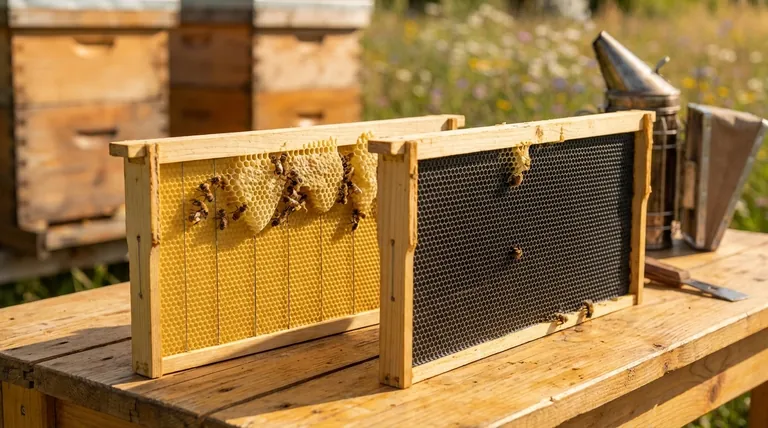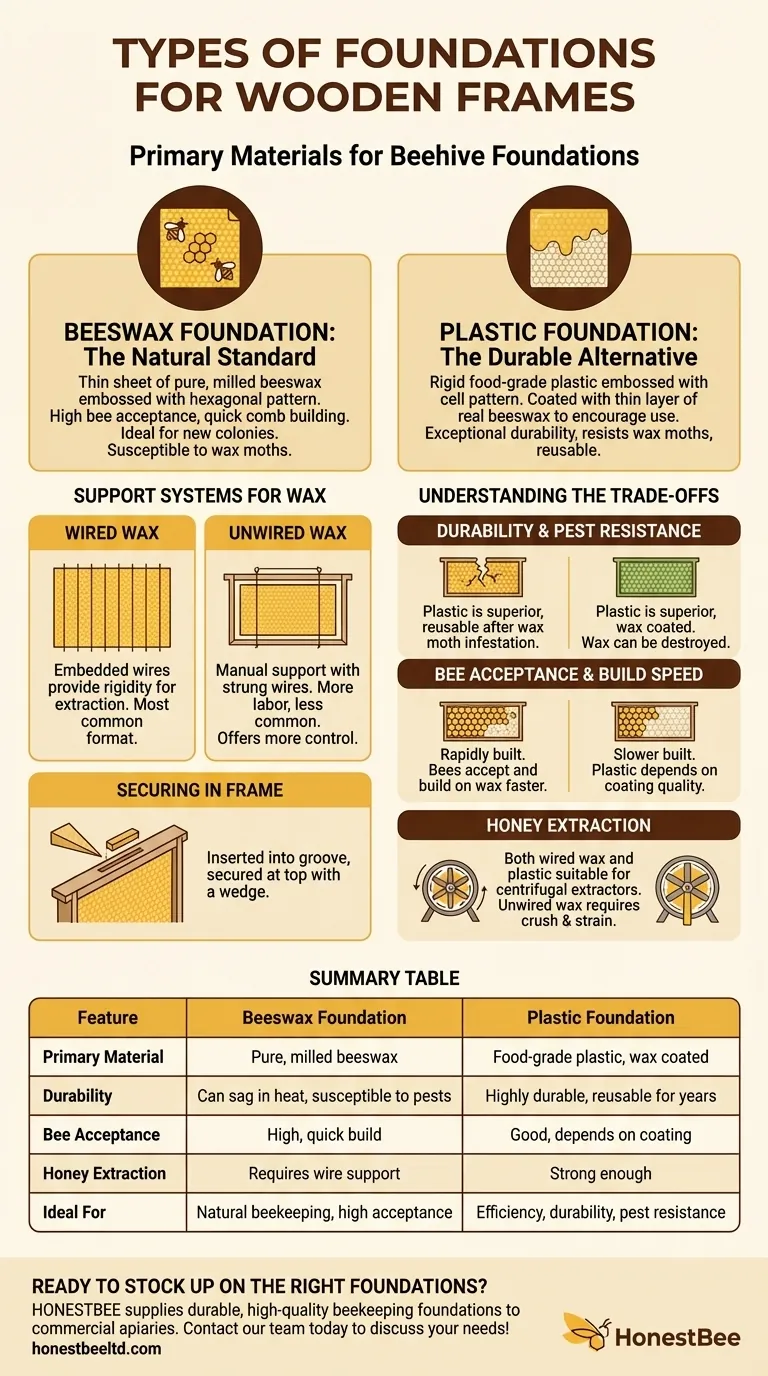In practice, there are two primary materials used for beehive foundations inside wooden frames: natural beeswax and molded plastic. While "wire" is often mentioned as a third type, it is more accurately a support system embedded within a wax foundation sheet to provide rigidity, not a foundation material on its own. The choice between wax and plastic has significant implications for hive management, durability, and honey extraction.
The core decision a beekeeper must make is between the natural appeal and high bee acceptance of beeswax foundation versus the superior durability, pest resistance, and long-term reusability of plastic foundation. This choice fundamentally shapes your equipment strategy and beekeeping workflow.

The Two Core Foundation Materials
The foundation you choose serves as a guide for the bees, encouraging them to build straight, uniform honeycomb within the removable frames. This is essential for easy hive inspections and honey harvesting.
Beeswax Foundation: The Natural Standard
Beeswax foundation is the traditional choice. It consists of a thin sheet of pure, milled beeswax embossed with the hexagonal pattern of a honeycomb cell base.
Bees are naturally drawn to real beeswax and typically begin building comb on it very quickly. This high acceptance rate makes it a reliable choice, especially for new colonies.
Plastic Foundation: The Durable Alternative
Plastic foundation is a rigid sheet of food-grade plastic, also embossed with a cell pattern. To encourage bees to use it, these sheets are almost always coated with a thin layer of real beeswax.
The primary advantage of plastic is its exceptional durability. It will not sag under heat, is resistant to damage from wax moths, and can be scraped clean and reused for many years.
Understanding Support Systems for Wax
Because beeswax is a soft material, it requires structural support within the wooden frame to prevent sagging, especially in warm weather or during honey extraction. This is where wiring becomes critical.
Wired Wax Foundation
This is the most common format for beeswax foundation. Wires are embedded vertically or horizontally directly into the wax sheet during manufacturing.
These wires provide essential rigidity, keeping the foundation centered and preventing it from "blowing out" or tearing apart in a centrifugal honey extractor.
Unwired Wax Foundation
Some beekeepers prefer unwired sheets of wax. These must be manually supported by stringing horizontal wires across the empty frame and then embedding the wax sheet onto those wires with a special tool.
This method offers more control but requires significantly more labor. It is often used by beekeepers pursuing "natural" or foundationless comb-building methods.
Securing the Foundation in the Frame
In a standard wooden frame, the foundation sheet (whether wax or plastic) is inserted into a groove in the bottom bar and secured at the top using a "wedge" or cleat that is nailed in place, pinching the foundation securely.
Understanding the Trade-offs
Choosing a foundation type is not about finding the "best" one, but the one that best aligns with your goals, budget, and management style.
Durability and Pest Resistance
Plastic is the clear winner here. Wax moths can completely destroy beeswax comb, but they cannot damage a plastic foundation. After an infestation, a plastic frame can be scraped clean and reused. A wax frame is a total loss.
Bee Acceptance and Build Speed
Bees will almost always accept and build on beeswax foundation faster than plastic. While the wax coating on plastic helps, a thin or poor-quality coating can lead to bees rejecting the frame entirely.
Honey Extraction
Both wired wax and plastic foundations are strong enough to withstand the forces of a centrifugal honey extractor. Unwired wax foundation, however, is extremely fragile and will likely disintegrate during mechanical extraction, making it suitable only for "crush and strain" honey harvesting.
Cost and Long-Term Value
Upfront costs are often comparable, but plastic foundation offers better long-term value due to its reusability. A single plastic foundation can outlast many sheets of wax foundation over the lifespan of a hive.
Making the Right Choice for Your Apiary
Your philosophy and priorities as a beekeeper should guide your decision.
- If your primary focus is natural beekeeping: Choose wired beeswax foundation for a balance of natural material and practical strength.
- If your primary focus is efficiency and durability: Choose high-quality, well-coated plastic foundation for its longevity and resistance to pests.
- If your primary focus is maximum honey production: Both wired wax and plastic are excellent choices, as their rigidity is essential for efficient mechanical extraction.
Ultimately, selecting your foundation is an early, critical decision that defines your relationship with your equipment and your bees.
Summary Table:
| Feature | Beeswax Foundation | Plastic Foundation |
|---|---|---|
| Primary Material | Pure, milled beeswax | Food-grade plastic with wax coating |
| Durability | Can sag in heat; susceptible to wax moths | Highly durable; reusable for years |
| Bee Acceptance | High; bees build comb quickly | Good, but depends on wax coating quality |
| Honey Extraction | Requires wire support for extractors | Strong enough for mechanical extractors |
| Ideal For | Natural beekeeping; high bee acceptance | Efficiency, durability, pest resistance |
Ready to stock up on the right foundations for your apiary? HONESTBEE supplies durable, high-quality beekeeping foundations and equipment to commercial apiaries and distributors through wholesale-focused operations. Let us help you build a more efficient and productive operation. Contact our team today to discuss your needs and place your order!
Visual Guide

Related Products
- Beeswax Foundation Sheets Beehive Foundation for Wholesale
- Professional Frame Preparation: The HONESTBEE Electric Wire Embedder
- Food Grade Plastic bee Foundation for Bee Frames
- Durable Rubberized Comfort Handle Frame Grip
- Durable Galvanized Steel Frame Grip
People Also Ask
- What are the characteristics of beeswax foundation? A Natural Choice for Healthy Hives
- What are wax sheets made of? A Guide to Pure Beeswax Foundation for Healthy Hives
- What happens after the flattening and embossing process is complete? From Molten Wax to Solid Foundation
- What is 'foundation' in beekeeping, and why is it used? Optimize Hive Management & Honey Production
- How do you store beeswax foundation? Prevent Wax Moth Damage and Preserve Quality



















